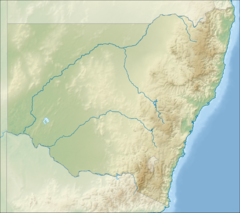Washpool National Park
| Washpool National Park | ||
|---|---|---|
| Washpool National Park | ||
|
|
||
| Location: | New South Wales , Australia | |
| Specialty: | Gorges, rainforests | |
| Surface: | 586.78 km² | |
| Founding: | 1983 | |
The Washpool National Park (English Washpool National Park) is a national park in the Australian state of New South Wales , about 80 km from Glen Innes and 90 km from Grafton . Sydney is around 500 km away. The park was placed under protection in 1983 and covers around 58,678 hectares.
General
The park is characterized by steep gorges, clear waters and extensive rainforests. These forests are some of the most undisturbed and biodiverse in New South Wales. It is home to the largest occurrence of the Coachwood tree ( Ceratopetalum apetalum ) in the world.
history
The designation of the national park was initially quite controversial, especially since the forest was considered a potential source of raw materials for wood production. However, it was recognized that this unique natural landscape must be preserved permanently, which is why it was designated a national park in 1983.
Wildlife
Especially in the park areas with old and dead trees, the park offers an important habitat for threatened mammals such as the Hastings River Mouse ( Pseudomys oralis ). Other notable species are the koala , the giant pouch marten , parma wallaby , red rat kangaroo , the rabbit kangaroo species Potorous tridactylus, and the narrow-footed pouch mouse . Over 140 species of birds have so far been recorded in the park, including the rust-bellied thicket bird and the giant owl ( Ninox strictua ).
The native flora and fauna are threatened by feral dogs, cats, pigs, goats and introduced foxes and deer.
tourism
The park offers hiking options of varying lengths and levels of difficulty, from short walks to tours lasting several days. There are also various resting and camping opportunities.
Further protection categories
In 1986 the national park was registered as part of Australia's Gondwana Rainforests UNESCO World Heritage Site and in 2007 on the Australian National Heritage List .
Web links
Individual evidence
- ↑ a b General Information from the Government of New South Wales
- ↑ Information from the National Park Administration on "problem species"
- ↑ Tour suggestions from the National Park Administration
- ↑ Information about camping opportunities
- ↑ Explanations on the designation as a UNESCO World Heritage Site

